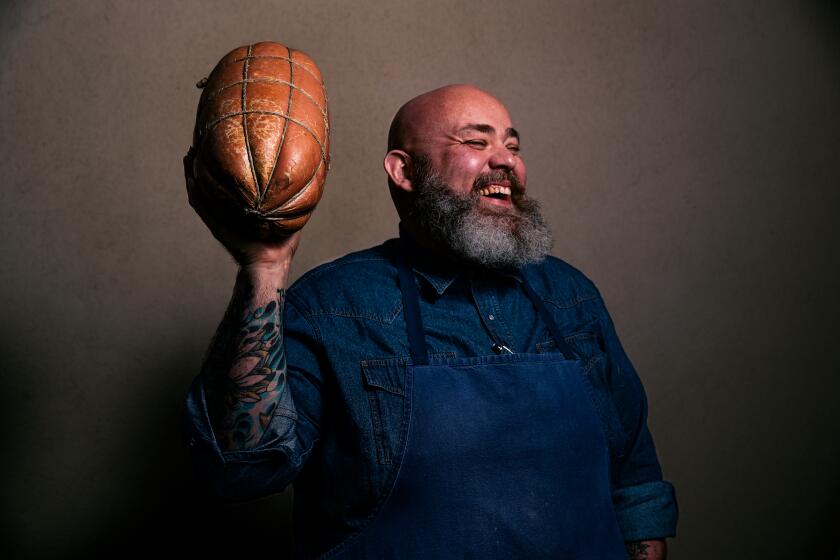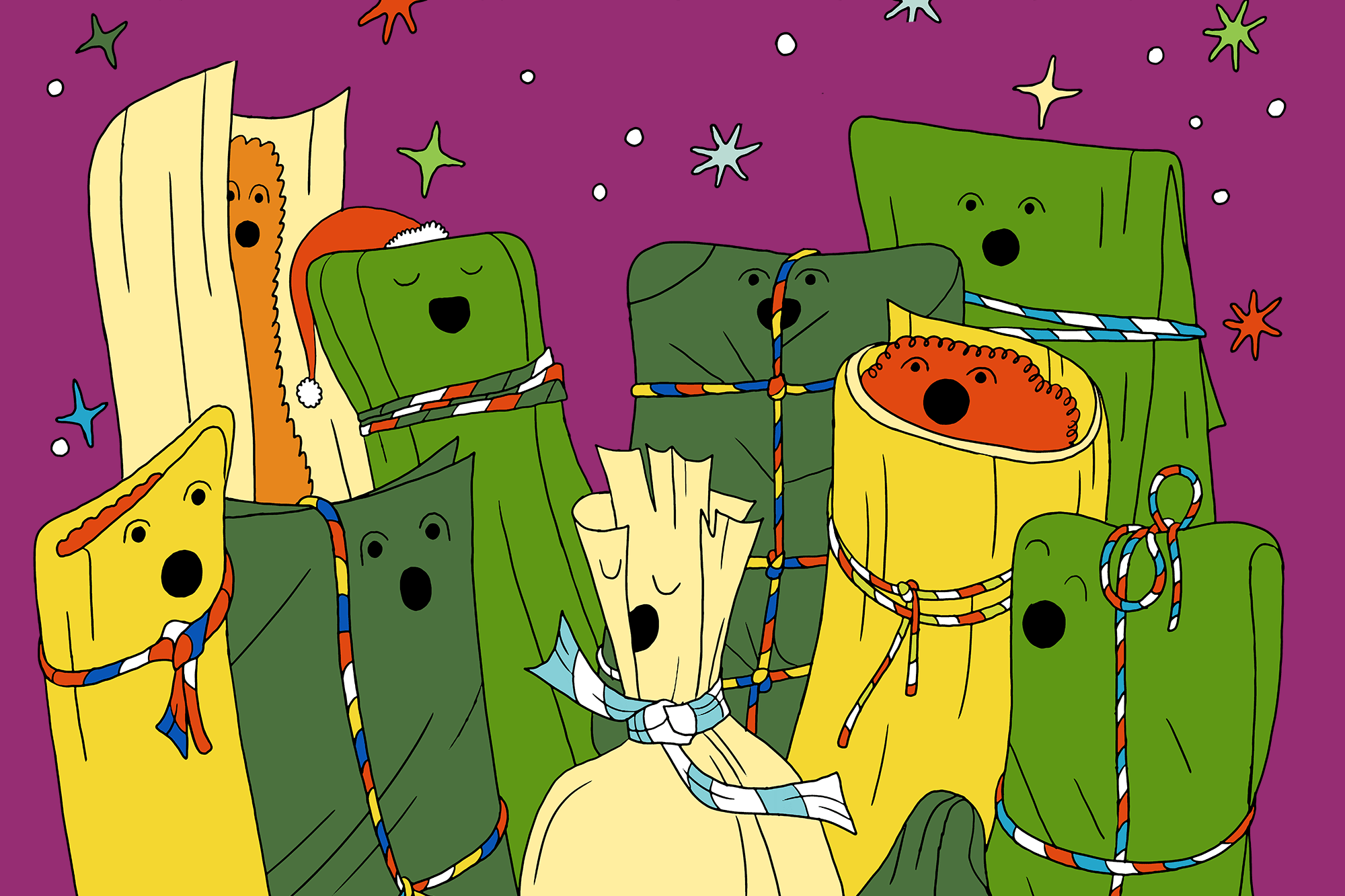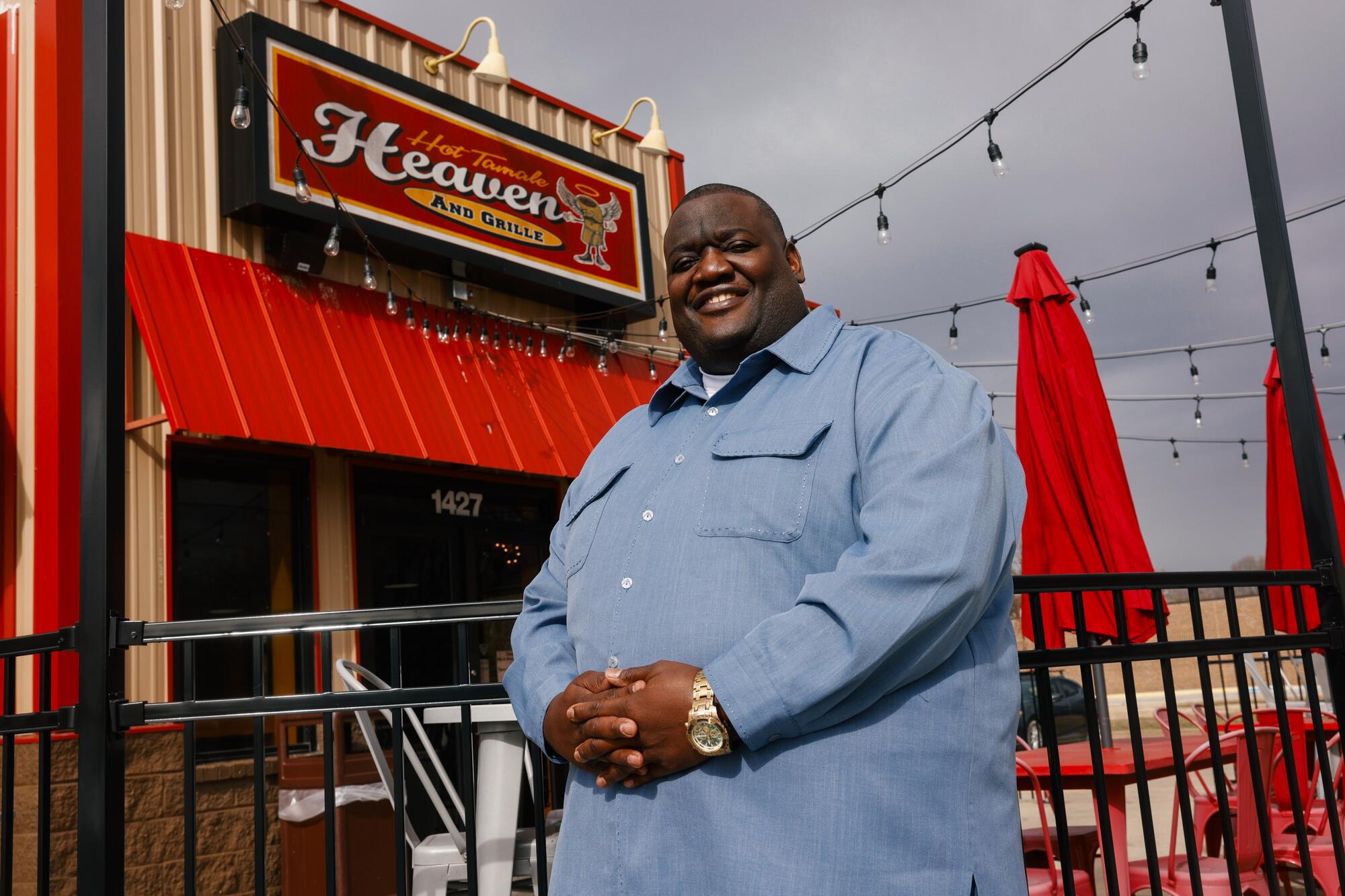
- Share via
MEMPHIS, Tenn. — When I moved to Memphis in 2021, brown asphalt roads, muggy air and an empty airport clearly signaled I wasn’t in L.A. anymore. It was my first time living outside South-Central, and I was incredibly homesick for months.
Over a year and a half, though, I stopped resisting the change and grew accustomed to Memphis culture, eating barbecue and seafood boils, going to Grizzlies games and saying “junt,” an all-encompassing colloquial local pronoun, on a regular basis. However, one culinary curiosity of the South — the hot tamale — showed me that a piece of home can be found anywhere.
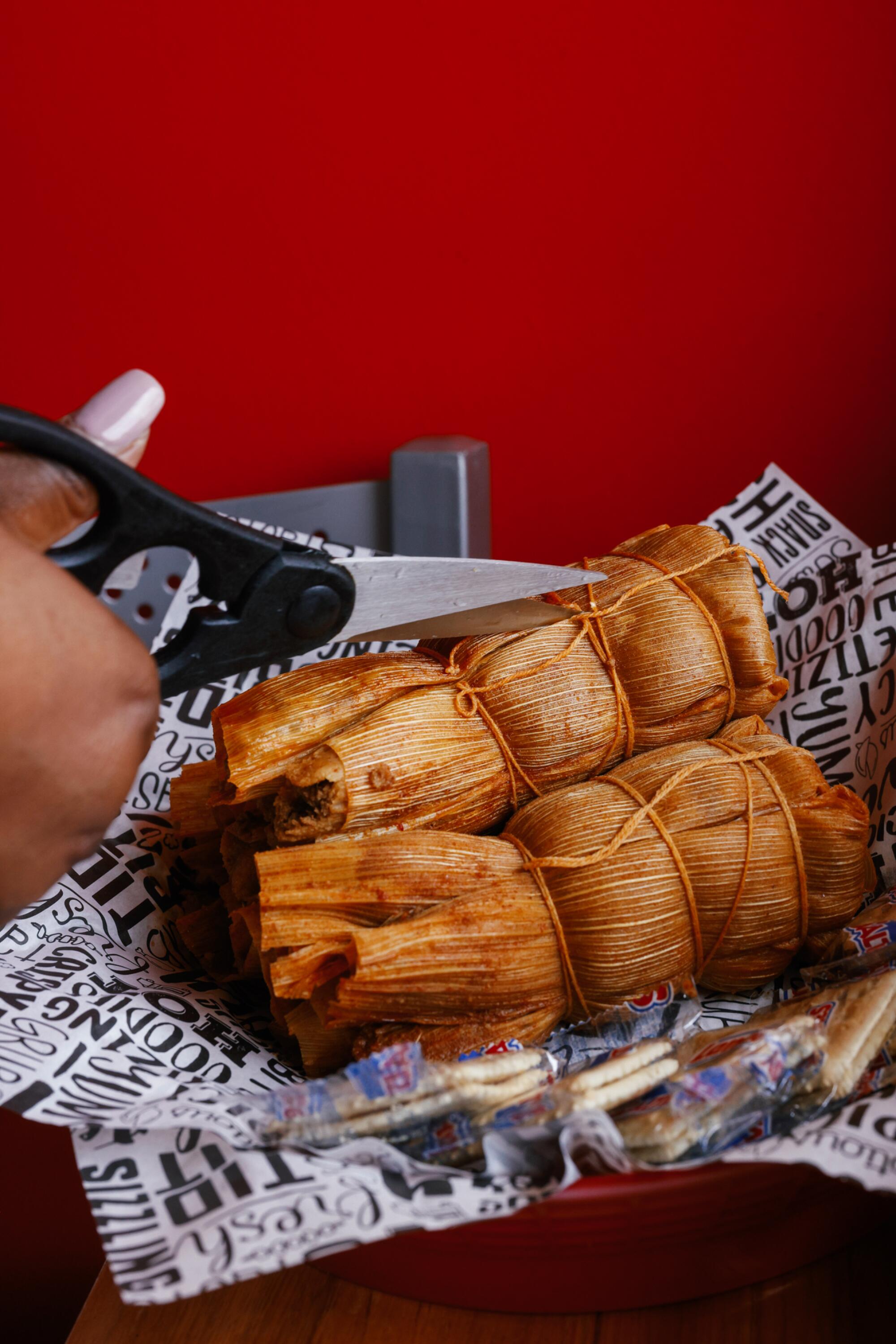
Hot tamales originated in the Mississippi Delta, a place marked culturally from Memphis south to Vicksburg, Miss., and west to some towns in eastern Arkansas. Well-known in the South, Delta-style tamales also managed to make it to SoCal for a period.
On first glance, they looked like the tamales I’d grown up eating, but further investigation revealed unique iterations of the wrapped and steamed Latin American staple.
From East Coast-style delis to Israeli-inspired sabich, L.A.’s rising sandwich scene reflects global influences and makes good use of seasonal produce.
How tamales landed in the Delta is unclear, but local culinary historians agree it’s most likely that they originated with Mexican migrant workers, who swapped recipes with Black Americans more than a century ago. And ever since, Black Southerners have been the keepers of the hot tamale tradition.
The Southern Foodways Alliance, a research organization at the University of Mississippi’s Center for the Study of Southern Culture, has been collecting oral stories of tamale makers in the state. The center developed the Hot Tamale Trail, which includes stops in Clarksdale and Greenville, in an effort to document the thriving scene in the Delta.
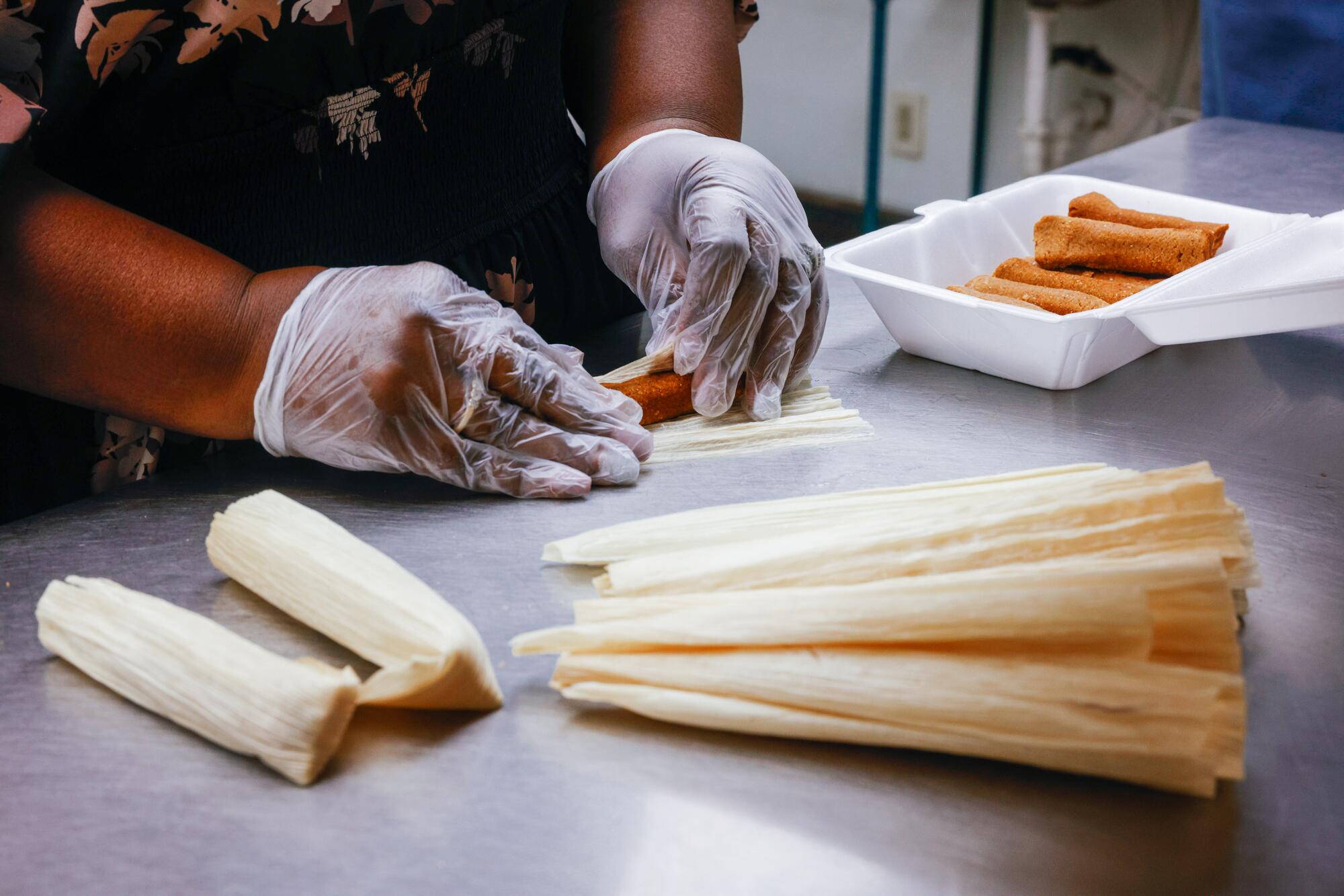
“They’re not different or odd to people in this area, but when you talk to people in other parts of the country, they’re like, ‘Tamales? In the Mississippi Delta?’” said Mary Beth Lasseter, the group’s interim co-director. “You can study a tamale and learn about many other things, like history, geography, economy.”
Key differences are their size and ingredients: Tamales in the American South are much smaller and typically stuffed with beef, wrapped in cornmeal and simmered in a spiced brine instead of steamed in water, keeping them moist and flavorful.
As much as Latin American tamales vary — olives in El Salvador, corn husk wrappings in Mexico or whole, bone-in chicken legs in Belize, red sauce or green — the variations in the South are as slight as their wrappings and as vast as their choices of meat. Lasseter mentions some shops that make custom tamales with venison meat brought in by customers.
Pink waves of mortadella — the Italian pork sausage that inspired bologna — are rippling over plates of antipasti, in sandwiches and on pizzas across L.A. It might even show up in your cocktail.
Greenville has coined itself the Hot Tamale Capital of the World. For the last 10 years, the Greater Greenville Housing and Revitalization Assn. has thrown the Delta Hot Tamale Festival, a celebration that includes blues music, pageants and tamale judging based on taste, texture and consistency.
According to the association, Greenville (population 29,000) earned the title because it has more hot tamale restaurants than anywhere else in the world. That’s apparent: Searching “hot tamales” in a GPS will yield 10 stores that sell them within a 10-mile radius of the city.

The festival has grown into Tamale-chella: a weekend-long event attracting more than 30,000 people from all over the world.
Trophies from the festival line the cashier’s counter at Hot Tamale Heaven. Among the honors are best presentation and first place commercial for years in a row.
Knowing their popularity, one woman drove from a neighboring town in Arkansas 10 days ahead of Christmas to ask owner Aaron Harmon whether six dozen tamales would be available. It’s that serious.
As to why Greenville became a hotbed, Harmon believes his family was the innovator, with a recipe so secret that he has his employees sign noncompete agreements.
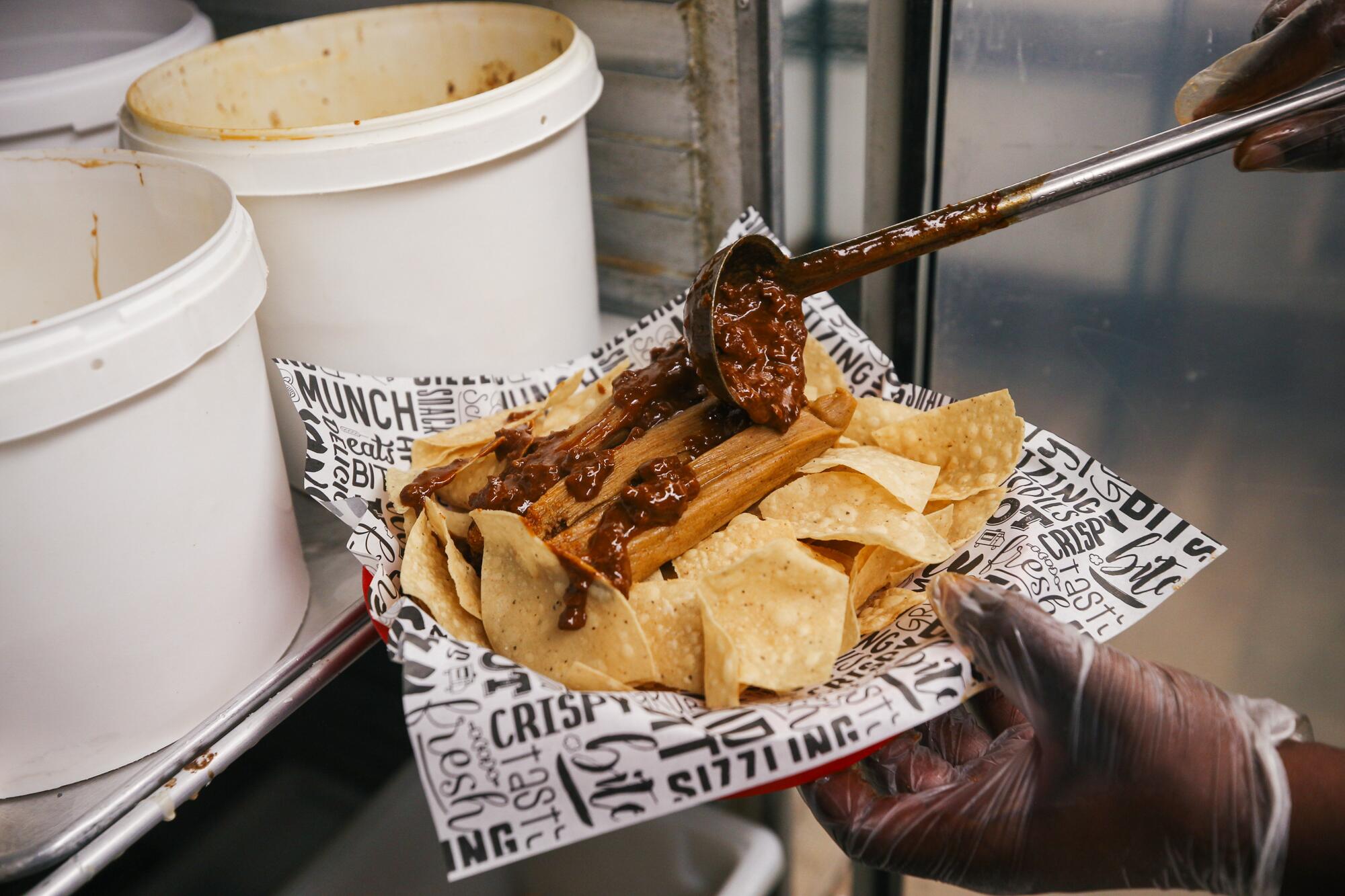
Back in the day, a young Harmon and his siblings would wake up early, in the thick air of a Delta morning, and travel from town to town with their father, selling tamales from a pushcart made out of bicycle parts.
Harmon claims his father’s was the first tamale cart in Greenville.
At the time, his father, Willie, was working in a factory, but his entrepreneurial spirit drove him to sell tamales part-time. Willie made $3 that first day. He and his wife, Inez, officially launched Hot Tamale Heaven in 1978, with Harmon and his siblings as their first tamale rollers. They opened their flagship drive-thru in 1997. Now, Aaron stands in the massive fast food-style location built on the foundation of that makeshift cart.
Where can you find the world’s best tamales in Los Angeles? This list features essential places near you, just in time for Christmas and New Year’s.
Their award-winning tamales look similar to Mexican ones, wrapped in corn husks and with grainy cornmeal, but the finely ground beef filling resembles col — the thick and sometimes semi-solid red filling — of some Central American tamales.
Today, Harmon sees the festival as a time for family members to come back to the Delta from across the U.S. and celebrate the foods they grew up on.
“It reminds you, I believe, of family and friends. It’s what you take to the ball games, what you take when you watch the playoffs, at a tailgate, that kind of thing,” he said. “It’s really a good time.”
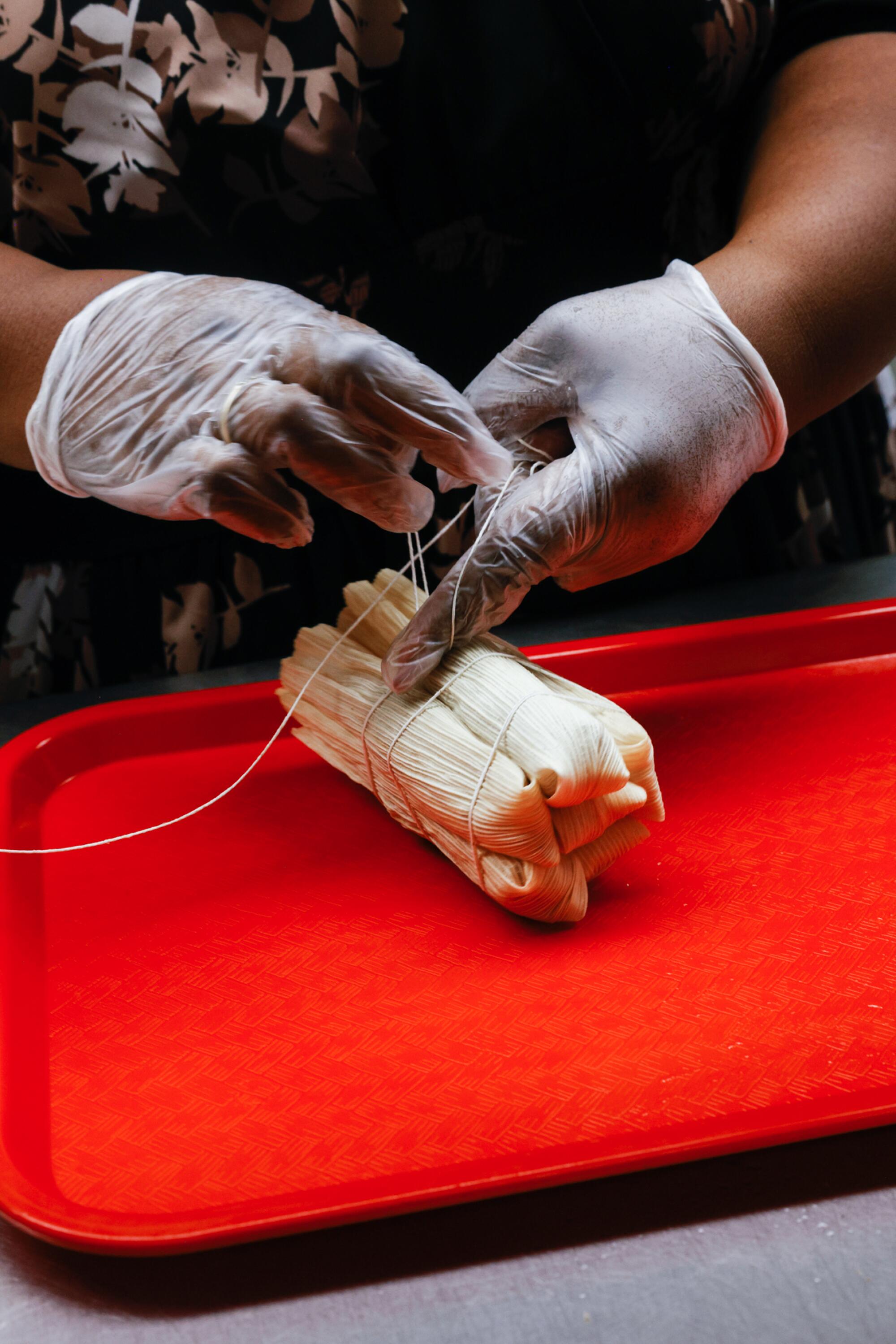
Hot Tamale Heaven’s menu also includes a fried tamale, coated in batter and deep fried to give it a flaky crust with a super soft filling, as well as tamale pie, which features three tamales smothered under house-made chili, queso, sour cream, chives and peppers.
Meanwhile, in Memphis
Six days a week, you can find Chauncey Harley and his wife, Keisha, selling greasy bags of hot tamales from their branded trailer in South Memphis. Hattie’s Tamales, one of the city’s oldest such shops, has been open for more than 50 years.
The stand goes back further than that, however, with family friend Josephine “Aunt Jo” Mickens selling tamales provided by local food entrepreneur Lester Dotson. Harley said Dotson saw Mexican cooks making tamales in Memphis and decided to get into the business, augmenting the recipe to make it “with soul.”
Harley’s father, Gayle “Shorty” Harley, invested in the tamale store in the mid-1980s. In the late ’90s, Shorty took on full ownership from Mickens, who died in 2003, and renamed it after his wife, Hattie.
The Harley family continued making tamales with an updated version of Dotson’s recipe.
First, Harley said, they boil vats of ground beef with secret seasoning. The texture is nearly that of an uncased sausage. From there, four ladies roll the meat in a barely-there layer of cornmeal dough and wrap it in parchment paper. After the tamales are finished, they’re frozen before being distributed to the company’s two trailers.
The tamales then are arranged in a spiral in large pots, soaking in bright red brine.
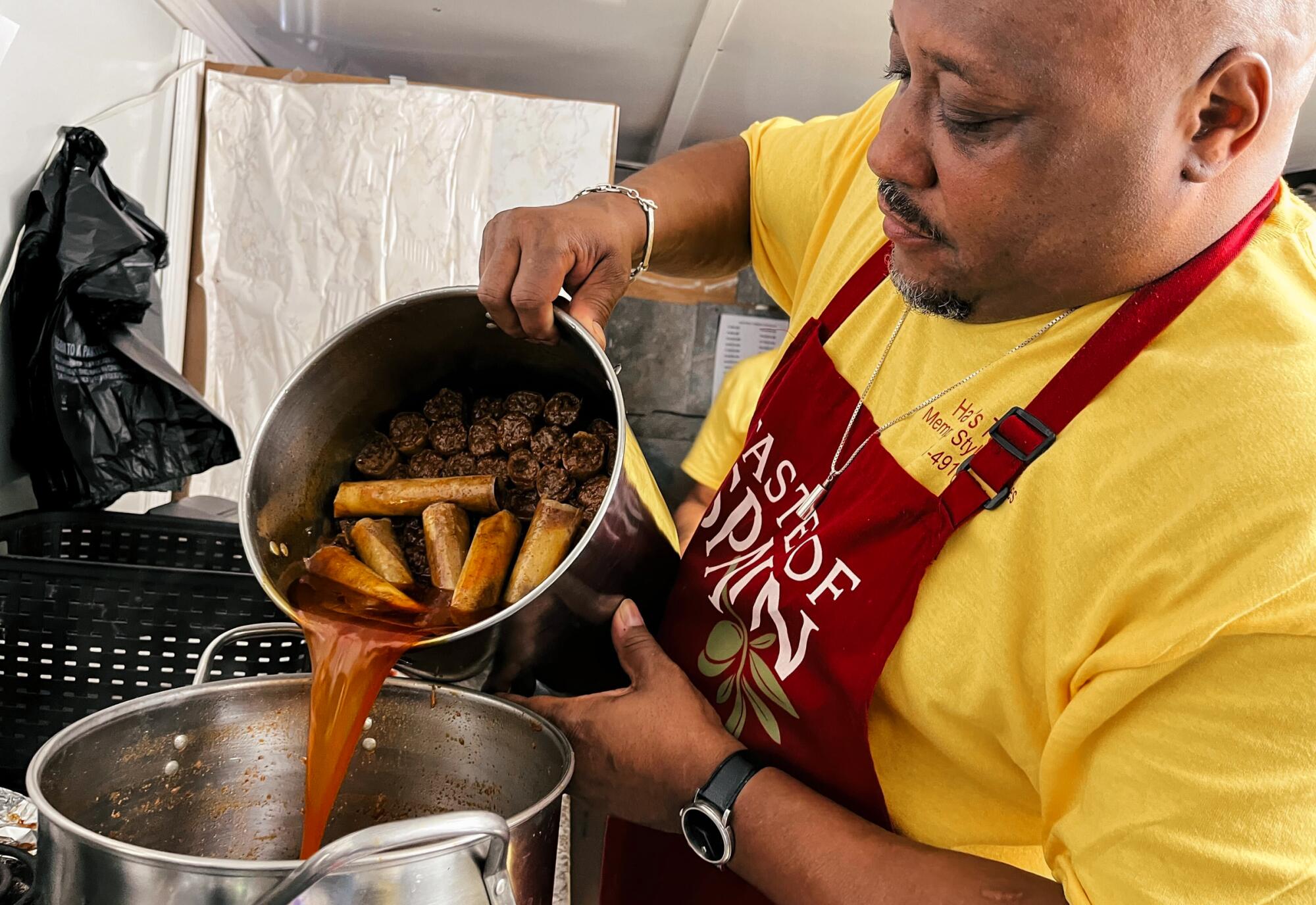
Hattie’s ensures that you’re getting more meat than masa — excuse me, cornmeal — on your fork. Harley declined to share his recipe, but the filling tasted like it was seasoned with cumin, chile powder and paprika. Harley sometimes serves his tamales with saltine crackers, which add a salty crunch.
Gerald Ellis pulled into the parking lot with his teenage son. Hattie’s is their favorite lunchtime spot.
“It’s a flavor you can’t explain,” said Ellis, adding that he’s been a patron since the 2000s. He stopped to order half a dozen mild tamales. “That’s what keeps you coming back.”
Ellis said he prefers Delta tamales to Latin American ones because he finds them more flavorful. Harley’s primary critique of Latin American tamales: “To me, it’s just bread.”
Although their recipe was inspired by Mexican cooks, the Harleys say they know the word tamale to mean “wrapped food,” and they see the dish as honoring how their ancestors stored food.
“Every Indigenous culture has some version of a food that’s wrapped in something. It might be a corn husk, maybe a banana leaf. It may be something, no matter where you go,” Harley said.
These differences — recipe to recipe, state to state — are a product of their living, with ingredients reflecting what’s readily available to them.

Harmon believes it’s necessity that birthed this tradition and that has kept it alive for generations. He attributes tamales’ popularity to working-class families that find them a filling, cheap and tasty meal.
“Once it’s done, then it’s not as much labor on the back end as it was on the front end. I think that may have had something to do with how it stuck around so long and how it lasted,” he said.
Harmon said he recalls the days when he could get a tamale for a nickel. Now, his tamales are just over a dollar each.
With many Black Angelenos having roots in the South, it doesn’t come as a surprise to find evidence of Southern-style tamales in L.A., or to find that there’s an L.A. take on the Delta-style tamale. In 1998, L.A. Times critic Charles Perry reported on the Mississippi-style hot tamales at Flossie’s (now closed), saying they featured the “aggressive ground chiles of a Mexican sauce and a dose of garlic and vinegar” and that they split “the difference between Mexico and Mississippi.”
Times restaurant critic Jonathan Gold spoke best about their irresistibility in 1991: “You can buy the tamales by the half-dozen … but you’d better get at least twice that if you want any left by the time you get home.”
Since coming back home, I’m thinking I should have ordered more to go.
Although they may not look like the variety we know, Delta tamales are a reflection of the lives of the people who create them: making do with what’s available and turning it into a precious heirloom.
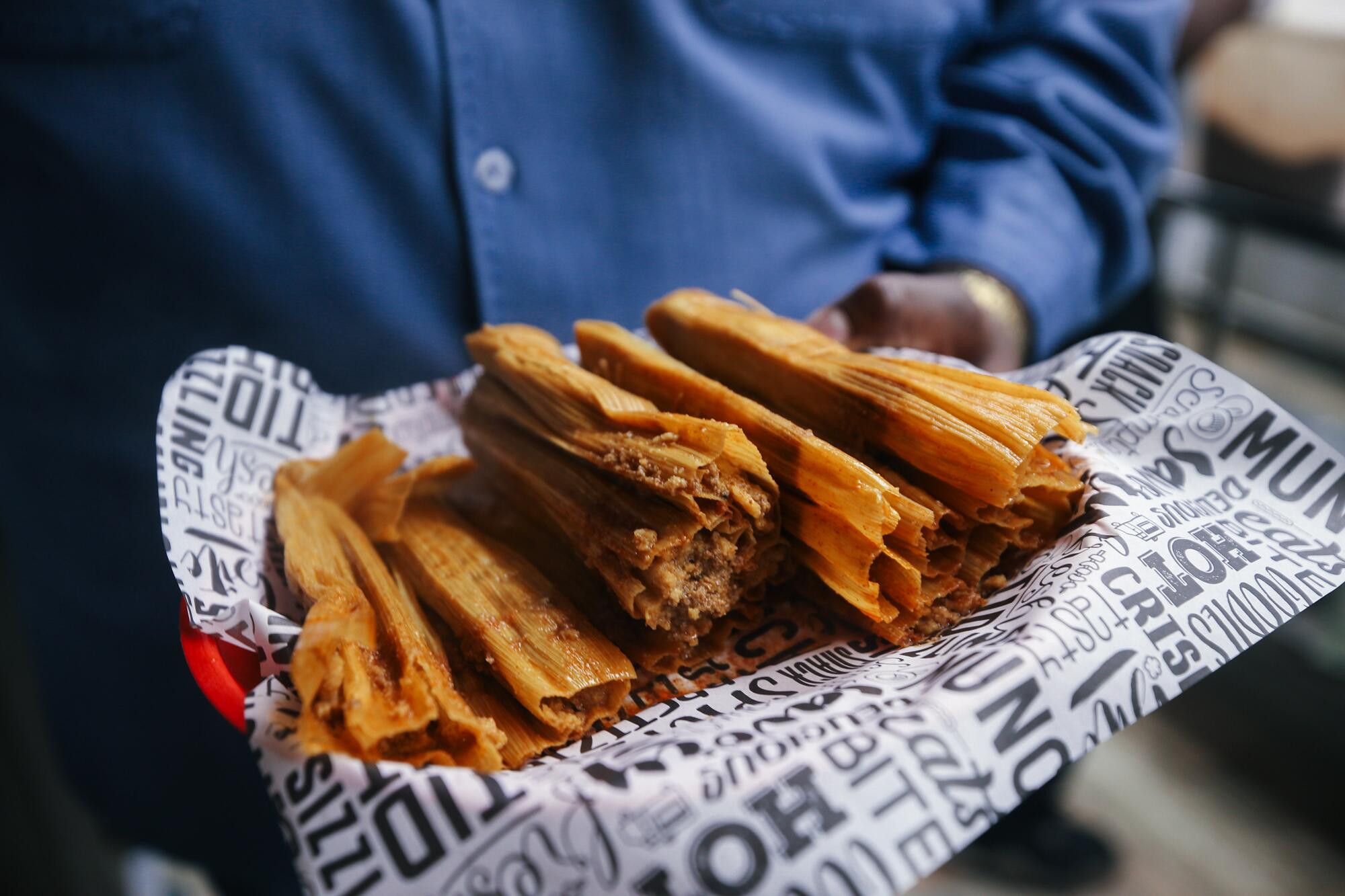
More to Read
Eat your way across L.A.
Get our weekly Tasting Notes newsletter for reviews, news and more.
You may occasionally receive promotional content from the Los Angeles Times.

